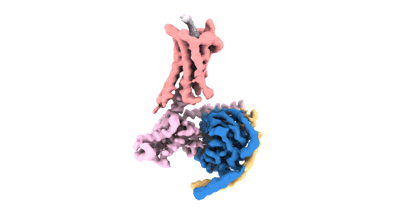EMD-32246
Cryo-EM structure of a monomeric GPCR-Gi complex with peptide
EMD-32246
Single-particle3.78 Å
 Deposition: 18/11/2021
Deposition: 18/11/2021Map released: 27/07/2022
Last modified: 20/11/2024
Sample Organism:
Homo sapiens
Sample: GPCR-Gi Complex
Fitted models: 7w0o (Avg. Q-score: 0.285)
Deposition Authors: Xu F ,
Yue Y
,
Yue Y
Sample: GPCR-Gi Complex
Fitted models: 7w0o (Avg. Q-score: 0.285)
Deposition Authors: Xu F
 ,
Yue Y
,
Yue Y
Structural insight into apelin receptor-G protein stoichiometry.
Yue Y,
Liu L,
Wu LJ  ,
Wu Y
,
Wu Y  ,
Wang L,
Li F,
Liu J,
Han GW,
Chen B,
Lin X
,
Wang L,
Li F,
Liu J,
Han GW,
Chen B,
Lin X  ,
Brouillette RL
,
Brouillette RL  ,
Breault E
,
Breault E  ,
Longpre JM
,
Longpre JM  ,
Shi S,
Lei H,
Sarret P
,
Shi S,
Lei H,
Sarret P  ,
Stevens RC,
Hanson MA
,
Stevens RC,
Hanson MA  ,
Xu F
,
Xu F 
(2022) Nat Struct Mol Biol , 29 , 688 - 697
 ,
Wu Y
,
Wu Y  ,
Wang L,
Li F,
Liu J,
Han GW,
Chen B,
Lin X
,
Wang L,
Li F,
Liu J,
Han GW,
Chen B,
Lin X  ,
Brouillette RL
,
Brouillette RL  ,
Breault E
,
Breault E  ,
Longpre JM
,
Longpre JM  ,
Shi S,
Lei H,
Sarret P
,
Shi S,
Lei H,
Sarret P  ,
Stevens RC,
Hanson MA
,
Stevens RC,
Hanson MA  ,
Xu F
,
Xu F 
(2022) Nat Struct Mol Biol , 29 , 688 - 697
Abstract:
The technique of cryogenic-electron microscopy (cryo-EM) has revolutionized the field of membrane protein structure and function with a focus on the dominantly observed molecular species. This report describes the structural characterization of a fully active human apelin receptor (APJR) complexed with heterotrimeric G protein observed in both 2:1 and 1:1 stoichiometric ratios. We use cryo-EM single-particle analysis to determine the structural details of both species from the same sample preparation. Protein preparations, in the presence of the endogenous peptide ligand ELA or a synthetic small molecule, both demonstrate these mixed stoichiometric states. Structural differences in G protein engagement between dimeric and monomeric APJR suggest a role for the stoichiometry of G protein-coupled receptor- (GPCR-)G protein coupling on downstream signaling and receptor pharmacology. Furthermore, a small, hydrophobic dimer interface provides a starting framework for additional class A GPCR dimerization studies. Together, these findings uncover a mechanism of versatile regulation through oligomerization by which GPCRs can modulate their signaling.
The technique of cryogenic-electron microscopy (cryo-EM) has revolutionized the field of membrane protein structure and function with a focus on the dominantly observed molecular species. This report describes the structural characterization of a fully active human apelin receptor (APJR) complexed with heterotrimeric G protein observed in both 2:1 and 1:1 stoichiometric ratios. We use cryo-EM single-particle analysis to determine the structural details of both species from the same sample preparation. Protein preparations, in the presence of the endogenous peptide ligand ELA or a synthetic small molecule, both demonstrate these mixed stoichiometric states. Structural differences in G protein engagement between dimeric and monomeric APJR suggest a role for the stoichiometry of G protein-coupled receptor- (GPCR-)G protein coupling on downstream signaling and receptor pharmacology. Furthermore, a small, hydrophobic dimer interface provides a starting framework for additional class A GPCR dimerization studies. Together, these findings uncover a mechanism of versatile regulation through oligomerization by which GPCRs can modulate their signaling.
